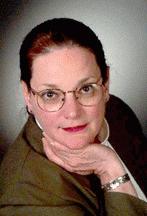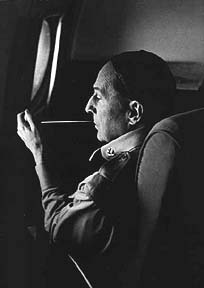|
|
An Appreciation of
Carl Mydans
by Marianne Fulton
|

|
History!
Carl Mydans is a great photographer.
Looking at his famous photographs of General Douglas MacArthur, listening
to Mydans talk about the camaraderie at LIFE, and reading his books, one
gains an appreciation for his vision, for the intelligence and sensitivity
that made him want to be part of the historical moment. This is not
just an appreciation of a photographer's pictures but of his humanity at
work in the twentieth century.
 Mydans has said that he has always been a people-watcher, looking at posture
and the telling gesture which might reveal something of the person. He
would watch mouths and look for falseness. As he began to understand this
unspoken language and interpret what he was so carefully observing he wrote,
"I had found a source of stories as wide and as varied and as captivating
as the human race."
Mydans has said that he has always been a people-watcher, looking at posture
and the telling gesture which might reveal something of the person. He
would watch mouths and look for falseness. As he began to understand this
unspoken language and interpret what he was so carefully observing he wrote,
"I had found a source of stories as wide and as varied and as captivating
as the human race."
As important, Mydans has a sense of history, and seemed to understand from
the beginning that his photographs were small emblems of contemporary history,
happening on the streets and in the war zones. Through accumulation, these
moments would meld together into a sense of a particular time and place.
Ironically, great war photographs seldom, if ever, show two sides battling
hand-to-hand to the finish. Distance is a secret presence and obstacle
in this genre of work. How does one impart an emotional understanding
of the larger situation, let alone tell a balanced story from only one
side within a constricted environment? One looks at incidents, individuals,
gestures, at the very things Mydans had trained himself to do when he perfected
his craft while working for Roy Stryker in the Farm Security Administration.
Perhaps his intuitive gift of empathy in the narrative unfolding before
him has been his greatest gift to the field.
If you think Mydans does not know what he's seeing or stands apart from
its impact, read his 1959 book More that Meets the Eye. It is one
of the most moving, beautiful photographic books produced in any decade.
Yet, there are no photographic reproductions in it. Instead, the
gut-level sense of the small moment symbolizing a larger conflict is related
time and again within the text. It is more than meets the eye - it
is the interior vision, the haunting memory, the shared agony of a man
in the midst of a world beyond his control. A philosopher once wrote
that one knew the quality of a person's mind through their writing. In
Mydans' first book, one also understands the quality and sources of one
man's vision. Not only through his intellect - his sense of purpose
- but also through an outpouring of feeling.
In literature, as in photography, the descriptive moment is yanked out
of the flow of events and held up for all to see. Done correctly, it has
a memorable impact. For example, in More Than Meets The Eye, there
is a story set during the Korean War of a Turkish doctor working in freezing
temperatures confronted with yet another dying man . Mydans sets
the scene:
"Late one afternoon in 1951, as the sun jumped behind the snow-covered
ridges of the Korean mountains, turning the top slush into crystals, a
Turkish patrol, shouting incom-prehensible words of recognition, struggled
back into their lines. They half-carried, half-dragged a poncho in
which quivered an incredible bundle. They moved in miniature through my
camera finder, hunched, silhouetted figures against the failing light."
Going into the tent with these cold men and there strange cargo, Mydans
watches the Turkish doctor pull back the edge of the poncho and peer inside.
There is a mound swaddled in roughly-made emergency bandages. Mydans continues,
"Two holes at the top showed black, glazed eyes. 'Turkish soldier,' said
the medic as he stood half-crouched beside me with a pair of scissors in
his hand. He struggled for his English. 'Turkish soldier,' he repeated.
And then angrily he pantomimed the scratching of a match and the torture
of fire.
As the bundle was slipped onto a litter and carried away to an ambulance
the doctor rose and faced the mountains. Pointing toward the darkening
horizon, he turned and shouted, 'History!' In exasperation he searched
for other English words, but they would not come. 'History,' he shouted
again and then stood jerking his fist into the air, looking wordlessly
toward the purple twilight."
This is the first page of the book. On the last, Mydans writes, "The sense
of history and drama comes to a man not because of who he is or what he
does but flickeringly, as he is caught up in events, as his personality
reacts, as he sees for a moment his place in the great flowing river of
time and humanity."
This is not supposed to be a book review, but just shy of 40 years later,
the verbal images Mydans creates are as moving as those he made with a
camera.
Let's look at two images of women: In "French woman accused of sleeping
with Germans during the occupation is shaved by vindictive neighbors in
a village near Marseilles," we see a woman being ridiculed by people on
the street. There is no place to run or any purpose in resistance.
She does not look rich, she wears a simple home-made blouse with rick-rack
sewn on for meager ornament. The composition of arms, eyes, the v-shaped
line of her accusers' heads, and the backlight of bright leafy summer lead
repeatedly to her closed eyes. We are very close. Was she the only collaborator
in the crowd? The taunting laughter from two onlookers and the sly glance
towards the camera by the man on the left make an uneasy moment with no
answers, only questions.
It is a caught moment, but interpreted photographically for maximum strength.
That is what sets Mydans apart from other photographers. It reiterates
his command of telling gesture and powerful arrangement.
Another woman, "A Korean mother carrying her baby and her worldly goods
flees the fighting around Seoul in the winter attack on the Korean capital
in 1951." For me, the sculptural quality of this image makes it one of
the most beautiful Mydans took during the war years.
As a curator, for me to call a war image "beautiful" reminds me of photographers
like Larry Burrows and Don McCullin who have agonized whether they were
somehow benefiting from the misery of those they photographed. I
have always admired Mary Ellen Mark's no nonsense reply to similar questions:
"Would you rather I did not take the photograph?" Meaning , in part, is
it easier for you not to look, not to know?
This photograph is exceptional. A young woman holding a precarious load
on her head, moving onward, suckles an infant bound to her body securely
in cloth, in the traditional fashion, while intensely concentrating - on
her steps? She cannot afford to fall. Or, lose her precious baggage. (Remember,
the caption states that there is fighting and an attack going on.)
She is the central subject of the image where everything is circular, antiquely
feminine, primordially important. She must make it. Besides showing a refugee,
this is about motherhood, about the human race.
There is another woman not often pictured in the gathering of Mydans' greatest
pictures. But, she is there, if only in his mind. It is Shelley
Smith Mydans. We see her in the early book at LIFE working late at night,
inundated with paperwork; Carl stops and asks what she is doing with all
these mathematical figures on scraps of paper. She replies that she is
balancing the budget - the national budget - for an article. Another insatiably
curious perfectionist, how could he not love her?
One of the great tributes to his wife and partner corespondent for LIFE
magazine, is found in More Than Meets the Eye. Mydans leaves alone
on another war assignment, leaving Shelley behind at Penn Station for the
first time. Contemplating the figure growing smaller on the platform,
he admits that he was still not completely sure of himself after the horror
of their shared Philippine imprisonment by the Japanese. He writes,
"And that night as I headed back to another front in another land, I was
suddenly aware that so much of the strength I had always thought was mine,
was Shelley's."
Carl Mydans is one of our best photographers. He has been everywhere.
For many years he worked under siege. He was not deterred from his vision
nor his obligation to tell the story. He was obsessive about keeping
notebooks containing captions and background material. Whenever humanly
possible he developed his film every night in various dark bathrooms across
the world so that LIFE would receive the story on time.
In the Pensées, the French philosopher Pascal observed that "the
greater the intellect one has, the more originality one finds in men. Ordinary
persons find no difference between men." Mydans has always seen the
uniqueness of each person. Look at his photographs.
- Marianne Fulton is the Chief Curator
at the George Eastman House in Rochester, New York, and a leading author
and authority on the history of photojournalism. |
